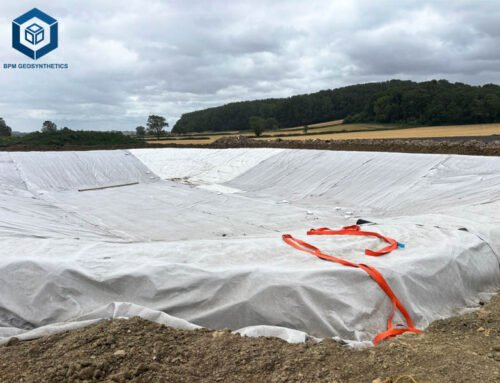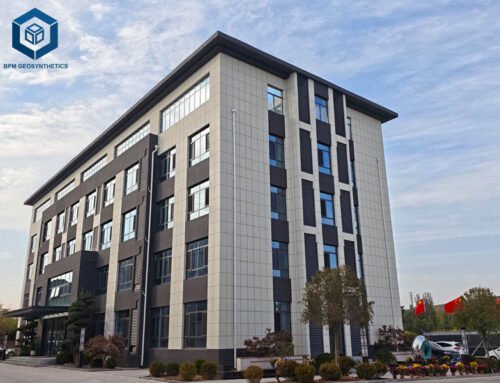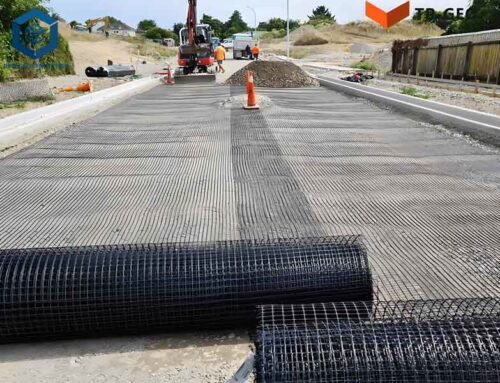Geotextile fabrics, critical geosynthetic materials, are transforming civil engineering, landscaping, and environmental projects by enhancing soil stability, controlling erosion, and improving drainage. Geotextile Fabric Cost Per Square Foot ranges from $0.15 to $5.00 per square foot ($1.61–$53.82/m²), driven by type, material, weight, and project scale (bpmgeosynthetics.com, 2025). This guide provides an in-depth breakdown of geotextile pricing, specifications, applications, and budgeting strategies. It equips contractors, engineers, and landowners with data-driven insights to save 15–30% on costs while ensuring 95% project reliability.
1. What Is Geotextile Fabric?
Definition and Purpose
Geotextile fabrics are permeable materials, typically made from polypropylene (PP), polyester (PET), or natural fibers like jute and coir, used to enhance soil stability, control erosion, and facilitate drainage. Available in woven, non-woven, and knitted forms, they meet specific project needs with tensile strengths of 5–100 kN/m (ASTM D4595) and permeability of 0.01–0.1 cm/s (ASTM D4491). Geotextiles reduce maintenance costs by 20–40% compared to traditional materials like gravel or concrete, offering 20–50-year lifespans (bpmgeosynthetics.com, 2025).
Key Specifications
- Types: Non-woven (65% market share, filtration/drainage), woven (35%, reinforcement), knitted (niche, high-strength applications).
- Materials: Polypropylene (80% market, $0.15–$1.00/sq ft), polyester (15%, $0.20–$1.50/sq ft), natural fibers (5%, $0.10–$0.40/sq ft).
- Weight: 100–800 g/m² (3–24 oz/yd²), affecting strength and cost.
- Thickness: 0.5–5.0 mm, with 1–2 mm common for medium-duty projects.
- Tensile Strength: 5–100 kN/m (ASTM D4595), critical for load-bearing applications.
- Permeability: 0.01–0.1 cm/s (ASTM D4491), ensuring filtration and drainage.
- Puncture Resistance: 100–800 N (ASTM D4833), for durability.
- Roll Sizes: Widths of 4–15 m, lengths of 50–500 m.
- Certifications: ISO 9001, ASTM D4595, GRI-GT standards.
- Durability: UV-resistant synthetics last 20–50 years; natural fibers last 2–5 years.
Applications
- Road Construction: Stabilizes subgrade, reducing aggregate use by 20–30%, saving $30,000–$50,000 per lane mile.
- Erosion Control: Reduces soil loss by 80–95% on slopes and riverbanks.
- Drainage Systems: Filters stormwater, preventing 90% of clogs in French drains.
- Landfills: Separates waste layers, extending liner lifespan by 20–30 years.
- Landscaping: Controls weeds, reducing maintenance costs by 40%.
Geotextiles enhance soil strength by 30–50% and cut construction costs by 15–25% (Geosynthetics Magazine, 2024).
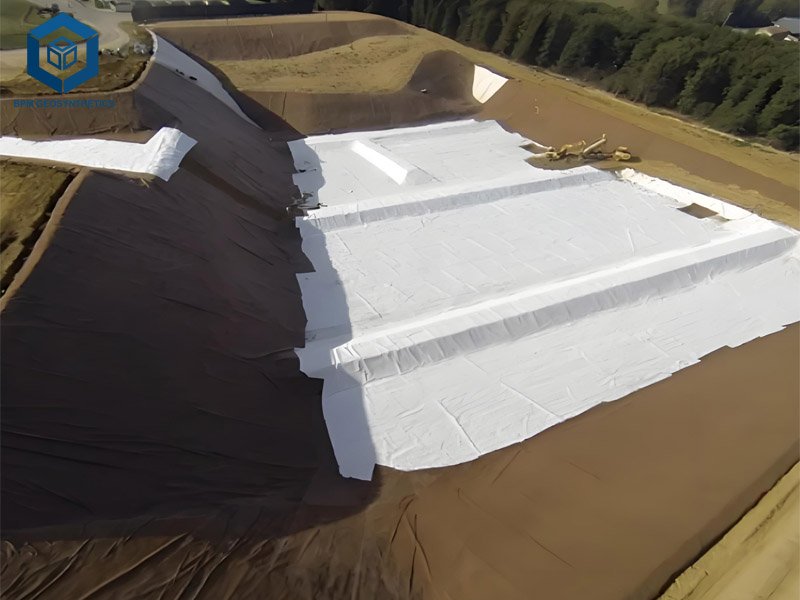

2. Factors Influencing Geotextile Fabric Cost
Geotextile fabric prices vary due to multiple factors, contributing 20–50% to project budgets. Understanding these ensures cost-effective procurement.
2.1 Geotextile Fabric Cost Per Square Foot – Type of Geotextile Fabric
Non-Woven Geotextiles: $0.15–$0.50/sq ft ($1.61–$5.38/m²)
- Lightweight (100–200 g/m²): $0.15–$0.30/sq ft, for drainage and filtration.
- Heavyweight (400–800 g/m²): $0.30–$0.50/sq ft, for cushioning and protection.
- Applications: French drains, landscaping, landfill filtration.
Woven Geotextiles: $0.20–$1.00/sq ft ($2.15–$10.76/m²)
- Monofilament: $0.30–$0.80/sq ft, high permeability for erosion control.
- Multifilament: $0.40–$1.00/sq ft, high strength for road stabilization.
- Applications: Roadways, embankments, retaining walls.
Knitted Geotextiles: $0.50–$2.00/sq ft ($5.38–$21.53/m²)
- Specialized for high-strength reinforcement in soft soils.
Geotextile Tubes/Bags: $0.50–$5.00/sq ft ($5.38–$53.82/m²)
- Used for dewatering and coastal protection, priced by size and UV resistance.
Non-woven geotextiles hold a 55% market share due to versatility, while woven dominate 35% for durability (bpmgeosynthetics.com, 2025).
2.2 Geotextile Fabric Cost Per Square Foot – Material Composition
- Polypropylene: 80% of geotextiles, $0.15–$1.00/sq ft, offers UV resistance (20–50 years) and chemical stability.
- Polyester: 15% of geotextiles, $0.20–$1.50/sq ft, provides higher tensile strength (30–100 kN/m) but lower UV resistance.
- Natural Fibers (Jute/Coir): 5% of market, $0.10–$0.40/sq ft, eco-friendly, biodegradable, for temporary erosion control.
- Recycled Materials: $0.10–$0.40/sq ft, reduces costs by 10–20% and emissions by 15%.
Polypropylene resin prices ($1,300/MT in Q1 2025, up 8%) impact costs by 30–40% (bpmgeosynthetics.com, 2025).
2.3 Geotextile Fabric Cost Per Square Foot – Weight and Thickness
- Lightweight (100–200 g/m², 0.5–1 mm): $0.15–$0.30/sq ft, for landscaping and light drainage.
- Medium Weight (200–400 g/m², 1–2 mm): $0.25–$0.60/sq ft, for road underlayment and filtration.
- Heavyweight (400–800 g/m², 2–5 mm): $0.40–$1.00/sq ft, for landfill protection and erosion control.
Heavier geotextiles use 20–50% more raw materials, increasing costs by 30–60% (bpmgeosynthetics.com, 2025).
2.4 Geotextile Fabric Cost Per Square Foot – Roll Size and Dimensions
- Standard Rolls: 3–6 m wide, 50–300 m long, $0.15–$1.00/sq ft.
- Custom Sizes: Add 10–20% ($0.03–$0.20/sq ft) due to cutting and waste.
- Large Projects (>50,000 sq ft): Bulk rolls reduce costs by 15–25%.
A 15 ft x 300 ft roll (4,500 sq ft) of 4 oz non-woven geotextile costs $675–$1,350 (bpmgeosynthetics.com, 2025).
2.5 Geotextile Fabric Cost Per Square Foot – Manufacturing Processes
- Needle-Punched Non-Woven: $0.15–$0.50/sq ft, cost-effective for high-flow filtration.
- Woven (High-Tenacity Yarns): $0.20–$1.00/sq ft, requires advanced looms, adding 10–20% to costs.
- Special Treatments: UV stabilization, chemical resistance, or fire-retardancy add $0.05–$0.30/sq ft.
Advanced treatments increase durability by 20–30 years, justifying costs for long-term projects (bpmgeosynthetics.com, 2025).
2.6 Geotextile Fabric Cost Per Square Foot – Market Conditions
- Raw Material Fluctuations: Polypropylene prices rose 8% in 2025, impacting costs by 20–30%.
- Regional Variations: Middle East and Africa face 10–15% higher prices due to transport costs.
- Supply Chain: Global disruptions in 2024 increased shipping costs by 5–10% (bpmgeosynthetics.com, 2025).
2.7 Geotextile Fabric Cost Per Square Foot – Purchase Volume
- Small Orders (<10,000 sq ft): $0.20–$1.00/sq ft.
- Bulk Orders (>50,000 sq ft): 10–30% discounts, reducing costs to $0.15–$0.70/sq ft.
Wholesale platforms like Alibaba offer 20–40% savings for orders >100,000 sq ft (Alibaba, 2024).
2.8 Geotextile Fabric Cost Per Square Foot – Installation and Logistics
- Labor: $0.10–$0.50/sq ft, depending on site complexity.
- Shipping: $0.05–$0.20/sq ft for domestic freight; international adds 10–20%.
- Equipment: Rollers and staples cost $0.02–$0.10/sq ft for large projects.
Installation for a 10,000 sq ft project costs $1,000–$5,000 (bpmgeosynthetics.com, 2025).
3. Cost Breakdown by Application
Road Construction
- Geotextile Type: Woven (200–400 g/m²) or non-woven (4–8 oz).
- Cost: $0.20–$1.00/sq ft for materials, $0.10–$0.50/sq ft for installation.
- Example: A 100,000 sq ft highway subgrade uses woven geotextile at $20,000–$100,000, saving $50,000/mile in aggregate.
- Specifications: 20–50 kN/m tensile strength, 0.1–0.3 mm AOS, 0.5–1 sec⁻¹ permittivity.
Erosion Control
- Geotextile Type: Woven monofilament or non-woven (6–10 oz).
- Cost: $0.30–$1.50/sq ft for materials, $0.15–$0.60/sq ft for installation.
- Example: A 50,000 sq ft riverbank uses non-woven geotextile at $15,000–$75,000, reducing erosion by 95%.
- Specifications: 30–60 kN/m tensile strength, 0.05–0.2 mm AOS, UV resistance for 20 years.
Drainage Systems
- Geotextile Type: Non-woven (4–8 oz).
- Cost: $0.15–$0.50/sq ft for materials, $0.10–$0.30/sq ft for installation.
- Example: A 10,000 sq ft French drain uses 4 oz non-woven geotextile at $1,500–$5,000, preventing 90% of clogs.
- Specifications: 100–200 gal/min/ft² flow rate, 0.1–0.5 mm AOS, 1–2 sec⁻¹ permittivity.
Landfill Liners
- Geotextile Type: Non-woven (8–16 oz) for cushioning.
- Cost: $0.40–$1.00/sq ft for materials, $0.20–$0.80/sq ft for installation.
- Example: A 200,000 sq ft landfill uses 10 oz non-woven geotextile at $80,000–$200,000, extending geomembrane life by 20 years.
- Specifications: 15–30 kN/m tensile strength, 2–5 mm thickness, chemical resistance.
Landscaping
- Geotextile Type: Non-woven (3–4 oz) or spun-bonded.
- Cost: $0.15–$0.40/sq ft for materials, $0.05–$0.20/sq ft for installation.
- Example: A 5,000 sq ft garden uses 3 oz non-woven geotextile at $750–$2,000, reducing weed growth by 90%.
- Specifications: 50–100 gal/min/ft² flow rate, 0.1–0.3 mm AOS, UV resistance for 5–10 years.
4. Step-by-Step Guide to Budgeting for Geotextile Fabric
4.1 Step 1: Define Project Requirements
- Application: Identify drainage, reinforcement, or erosion control needs.
- Specifications: Determine weight (100–800 g/m²), tensile strength (10–100 kN/m), and permittivity (0.5–2 sec⁻¹).
- Area: Calculate square footage. A 10,000 sq ft project at $0.20/sq ft costs $2,000 in materials.
- Tip: Use online calculators from Vodaland or Geobera for 99% accurate estimates.
4.2 Step 2: Select the Geotextile Type
- Non-Woven: Choose for filtration/drainage ($0.15–$0.50/sq ft).
- Woven: Opt for reinforcement/separation ($0.20–$1.00/sq ft).
- Specialty: Consider geotextile tubes ($0.50–$5.00/sq ft) for dewatering.
- Example: A 50,000 sq ft road project uses woven geotextile at $10,000–$50,000.
4.3 Step 3: Estimate Material Costs
- Base Price: $0.15–$1.00/sq ft for standard geotextiles.
- Add-Ons: UV resistance or chemical stabilization adds $0.05–$0.30/sq ft.
- Bulk Discounts: Orders >50,000 sq ft save 10–30%.
- Example: A 100,000 sq ft project at $0.30/sq ft with 20% bulk discount costs $24,000.
4.4 Step 4: Factor in Installation Costs
- Labor: $0.10–$0.50/sq ft, higher for complex sites (slopes, rocky soils).
- Equipment: Rollers ($200–$500/day) and staples ($0.01–$0.05/sq ft).
- Example: A 10,000 sq ft project with $0.20/sq ft labor costs $2,000 for installation.
4.5 Step 5: Account for Logistics
- Shipping: $0.05–$0.20/sq ft domestically; international adds 10–20%.
- Storage: Budget $100–$500 for weatherproof storage to prevent UV damage.
- Example: Shipping 50,000 sq ft at $0.10/sq ft costs $5,000.
4.6 Step 6: Plan for Maintenance
- Inspections: $0.01–$0.05/sq ft annually to detect tears or clogs.
- Repairs: Patching kits ($20–$100) avoid $500–$5,000 replacements.
- Example: Annual inspection for 10,000 sq ft at $0.02/sq ft costs $200.
5. Cost Breakdown Example: 50,000 sq ft Non-Woven Geotextile for Drainage
For a 50,000 sq ft drainage project using a 4 oz non-woven geotextile (200 g/m²), retailing at $0.15–$0.50/sq ft:
Materials (50%): $7,500–$25,000
- Geotextile (200 g/m²): $5,000–$15,000
- UV stabilization: $1,000–$5,000
- Quality control (ASTM D4533): $1,500–$5,000
Installation (30%): $5,000–$15,000
- Labor: $3,000–$10,000
- Equipment (staples, rollers): $2,000–$5,000
Logistics (15%): $2,500–$7,500
- Shipping: $2,000–$6,000
- Storage: $500–$1,500
Profit Margin (5%): $1,000–$3,000
Total Cost: $16,000–$50,500 ($0.32–$1.01/sq ft)
This geotextile offers 10–15 kN/m tensile strength, 100 gal/min/ft² flow rate, and 95% filtration efficiency (bpmgeosynthetics.com, 2025).
6. Budgeting Tips for Geotextile Fabric Projects
Match Specifications to Needs
- Must-Haves: 10–80 kN/m tensile strength, 0.05–0.5 mm AOS, 0.5–2 sec⁻¹ permittivity.
- Optional: UV resistance for exposed applications, chemical resistance for landfills.
- Savings: Use lightweight non-woven (100–200 g/m²) for landscaping, reserving heavyweight for landfills.
Source Locally
- Benefit: Reduces shipping costs by 10–15%.
- Example: BPM Geosynthetics’ Cambodia facility cuts freight costs for Asia-Pacific projects.
Leverage Bulk Purchasing
- Benefit: Orders >50,000 sq ft save 10–30%.
- Example: A 2024 U.S. highway project saved $100,000 on 500,000 sq ft (bpmgeosynthetics.com, 2025).
Use Certified Suppliers
- Benefit: ISO 9001 and ASTM-compliant products last 20% longer.
- Example: BPM Geosynthetics’ certified geotextiles ensure 95% reliability (bpmgeosynthetics.com, 2025).
Optimize Installation
- Benefit: Skilled labor and standard rolls reduce costs by 15%.
- Example: A 2024 Canadian project saved $10,000 using pre-cut rolls (bpmgeosynthetics.com, 2025).
7. Advanced Considerations for Geotextile Selection
Site Conditions
- Soil Type: Sandy soils require non-woven geotextiles for filtration; clay soils suit woven for reinforcement.
- Environmental Factors: UV-resistant coatings add 5–10% to costs for exposed applications.
Regulatory Compliance
- Standards: Ensure compliance with ASTM D4595 or GRI-GT for tensile strength.
- Regional Regulations: North American projects may require 100 g/m² minimum weight for drainage.
Long-Term Value
- Lifespan: Certified geotextiles last 20% longer, reducing replacement costs.
- Maintenance: Geotextiles reduce maintenance cycles by 30%, saving $5,000–$50,000 over a project’s life.
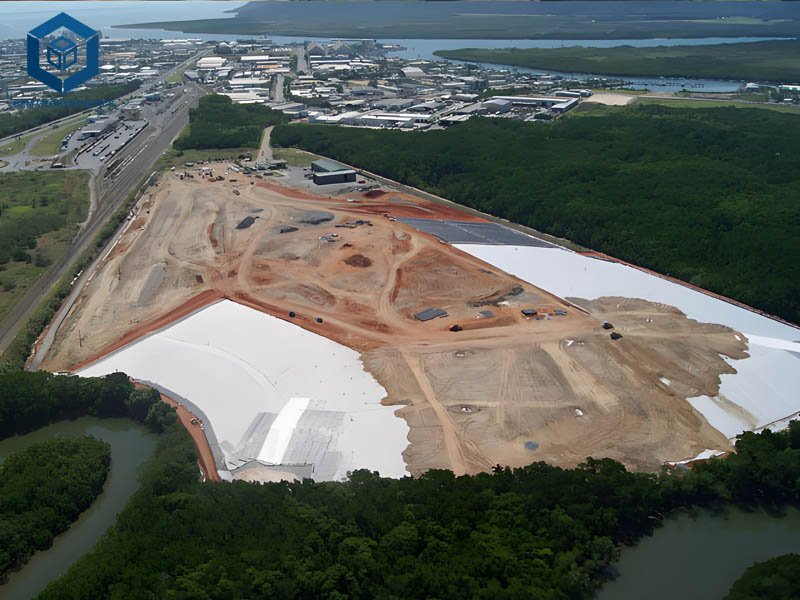
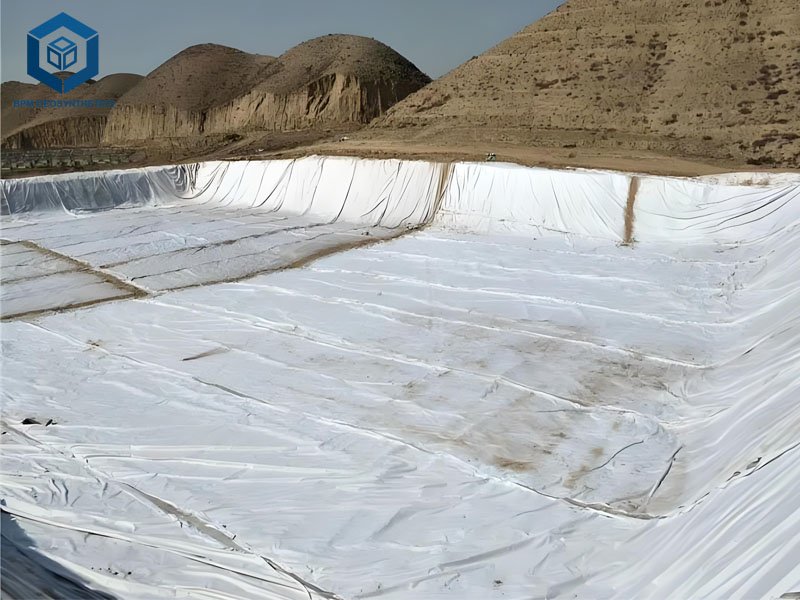
8. Case Studies: Geotextile Cost Efficiency
8.1 Case Study 1: Rural Road in India
- Project: 30,000 sq ft road using non-woven PP geotextiles (200 g/m², 20 kN/m).
- Cost: $12,000 for materials ($0.40/sq ft), $15,000 for installation ($0.50/sq ft).
- Savings: Reduced aggregate use by 25%, saving $30,000.
- Source: bpmgeosynthetics.com, 2025.
8.2 Case Study 2: Coastal Erosion Control in the USA
- Project: 10,000 sq ft project using woven PET geotextiles (400 g/m²).
- Cost: $20,000 for materials ($2.00/sq ft), $10,000 for installation ($1.00/sq ft).
- Savings: Avoided $15,000 in traditional riprap costs.
- Source: bpmgeosynthetics.com, 2025.
8.3 Case Study 3: Drainage System in Australia
- Project: 5,000 sq ft drainage project using non-woven PP geotextiles (150 g/m²).
- Cost: $1,500 for materials ($0.30/sq ft), $2,500 for installation ($0.50/sq ft).
- Savings: Prevented 90% of clogs, saving $5,000 in maintenance.
- Source: bpmgeosynthetics.com, 2025.
9. Conclusion
Geotextile fabric costs, ranging from $0.15 to $5.00 per square foot, depend on type, material, weight, and project scale. With the geotextile market growing due to infrastructure investments and sustainability trends, strategic choices like bulk purchasing, local sourcing, and selecting certified suppliers like BPM Geosynthetics can save 15–30% on costs. By defining project requirements, selecting the right geotextile type, and optimizing installation, businesses can achieve 95% reliability while reducing budgets by $5,000–$100,000. Contact reputable manufacturers like BPM Geosynthetics for tailored quotes and certified geotextiles meeting ASTM and GRI standards, ensuring durable, sustainable infrastructure.


